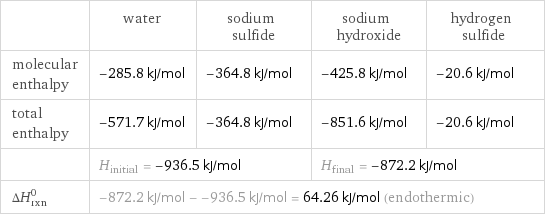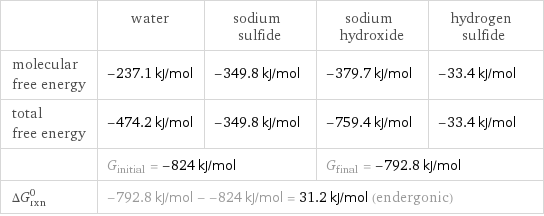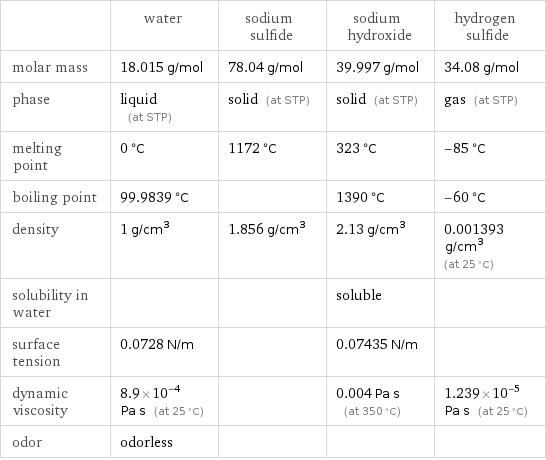Input interpretation

H_2O water + Na_2S sodium sulfide ⟶ NaOH sodium hydroxide + H_2S hydrogen sulfide
Balanced equation

Balance the chemical equation algebraically: H_2O + Na_2S ⟶ NaOH + H_2S Add stoichiometric coefficients, c_i, to the reactants and products: c_1 H_2O + c_2 Na_2S ⟶ c_3 NaOH + c_4 H_2S Set the number of atoms in the reactants equal to the number of atoms in the products for H, O, Na and S: H: | 2 c_1 = c_3 + 2 c_4 O: | c_1 = c_3 Na: | 2 c_2 = c_3 S: | c_2 = c_4 Since the coefficients are relative quantities and underdetermined, choose a coefficient to set arbitrarily. To keep the coefficients small, the arbitrary value is ordinarily one. For instance, set c_2 = 1 and solve the system of equations for the remaining coefficients: c_1 = 2 c_2 = 1 c_3 = 2 c_4 = 1 Substitute the coefficients into the chemical reaction to obtain the balanced equation: Answer: | | 2 H_2O + Na_2S ⟶ 2 NaOH + H_2S
Structures

+ ⟶ +
Names

water + sodium sulfide ⟶ sodium hydroxide + hydrogen sulfide
Reaction thermodynamics
Enthalpy

| water | sodium sulfide | sodium hydroxide | hydrogen sulfide molecular enthalpy | -285.8 kJ/mol | -364.8 kJ/mol | -425.8 kJ/mol | -20.6 kJ/mol total enthalpy | -571.7 kJ/mol | -364.8 kJ/mol | -851.6 kJ/mol | -20.6 kJ/mol | H_initial = -936.5 kJ/mol | | H_final = -872.2 kJ/mol | ΔH_rxn^0 | -872.2 kJ/mol - -936.5 kJ/mol = 64.26 kJ/mol (endothermic) | | |
Gibbs free energy

| water | sodium sulfide | sodium hydroxide | hydrogen sulfide molecular free energy | -237.1 kJ/mol | -349.8 kJ/mol | -379.7 kJ/mol | -33.4 kJ/mol total free energy | -474.2 kJ/mol | -349.8 kJ/mol | -759.4 kJ/mol | -33.4 kJ/mol | G_initial = -824 kJ/mol | | G_final = -792.8 kJ/mol | ΔG_rxn^0 | -792.8 kJ/mol - -824 kJ/mol = 31.2 kJ/mol (endergonic) | | |
Equilibrium constant
![Construct the equilibrium constant, K, expression for: H_2O + Na_2S ⟶ NaOH + H_2S Plan: • Balance the chemical equation. • Determine the stoichiometric numbers. • Assemble the activity expression for each chemical species. • Use the activity expressions to build the equilibrium constant expression. Write the balanced chemical equation: 2 H_2O + Na_2S ⟶ 2 NaOH + H_2S Assign stoichiometric numbers, ν_i, using the stoichiometric coefficients, c_i, from the balanced chemical equation in the following manner: ν_i = -c_i for reactants and ν_i = c_i for products: chemical species | c_i | ν_i H_2O | 2 | -2 Na_2S | 1 | -1 NaOH | 2 | 2 H_2S | 1 | 1 Assemble the activity expressions accounting for the state of matter and ν_i: chemical species | c_i | ν_i | activity expression H_2O | 2 | -2 | ([H2O])^(-2) Na_2S | 1 | -1 | ([Na2S])^(-1) NaOH | 2 | 2 | ([NaOH])^2 H_2S | 1 | 1 | [H2S] The equilibrium constant symbol in the concentration basis is: K_c Mulitply the activity expressions to arrive at the K_c expression: Answer: | | K_c = ([H2O])^(-2) ([Na2S])^(-1) ([NaOH])^2 [H2S] = (([NaOH])^2 [H2S])/(([H2O])^2 [Na2S])](../image_source/db838c25dc9e724e2f78a0badb87000a.png)
Construct the equilibrium constant, K, expression for: H_2O + Na_2S ⟶ NaOH + H_2S Plan: • Balance the chemical equation. • Determine the stoichiometric numbers. • Assemble the activity expression for each chemical species. • Use the activity expressions to build the equilibrium constant expression. Write the balanced chemical equation: 2 H_2O + Na_2S ⟶ 2 NaOH + H_2S Assign stoichiometric numbers, ν_i, using the stoichiometric coefficients, c_i, from the balanced chemical equation in the following manner: ν_i = -c_i for reactants and ν_i = c_i for products: chemical species | c_i | ν_i H_2O | 2 | -2 Na_2S | 1 | -1 NaOH | 2 | 2 H_2S | 1 | 1 Assemble the activity expressions accounting for the state of matter and ν_i: chemical species | c_i | ν_i | activity expression H_2O | 2 | -2 | ([H2O])^(-2) Na_2S | 1 | -1 | ([Na2S])^(-1) NaOH | 2 | 2 | ([NaOH])^2 H_2S | 1 | 1 | [H2S] The equilibrium constant symbol in the concentration basis is: K_c Mulitply the activity expressions to arrive at the K_c expression: Answer: | | K_c = ([H2O])^(-2) ([Na2S])^(-1) ([NaOH])^2 [H2S] = (([NaOH])^2 [H2S])/(([H2O])^2 [Na2S])
Rate of reaction
![Construct the rate of reaction expression for: H_2O + Na_2S ⟶ NaOH + H_2S Plan: • Balance the chemical equation. • Determine the stoichiometric numbers. • Assemble the rate term for each chemical species. • Write the rate of reaction expression. Write the balanced chemical equation: 2 H_2O + Na_2S ⟶ 2 NaOH + H_2S Assign stoichiometric numbers, ν_i, using the stoichiometric coefficients, c_i, from the balanced chemical equation in the following manner: ν_i = -c_i for reactants and ν_i = c_i for products: chemical species | c_i | ν_i H_2O | 2 | -2 Na_2S | 1 | -1 NaOH | 2 | 2 H_2S | 1 | 1 The rate term for each chemical species, B_i, is 1/ν_i(Δ[B_i])/(Δt) where [B_i] is the amount concentration and t is time: chemical species | c_i | ν_i | rate term H_2O | 2 | -2 | -1/2 (Δ[H2O])/(Δt) Na_2S | 1 | -1 | -(Δ[Na2S])/(Δt) NaOH | 2 | 2 | 1/2 (Δ[NaOH])/(Δt) H_2S | 1 | 1 | (Δ[H2S])/(Δt) (for infinitesimal rate of change, replace Δ with d) Set the rate terms equal to each other to arrive at the rate expression: Answer: | | rate = -1/2 (Δ[H2O])/(Δt) = -(Δ[Na2S])/(Δt) = 1/2 (Δ[NaOH])/(Δt) = (Δ[H2S])/(Δt) (assuming constant volume and no accumulation of intermediates or side products)](../image_source/4a37568e1e5d4e31c1f6cfb28619470b.png)
Construct the rate of reaction expression for: H_2O + Na_2S ⟶ NaOH + H_2S Plan: • Balance the chemical equation. • Determine the stoichiometric numbers. • Assemble the rate term for each chemical species. • Write the rate of reaction expression. Write the balanced chemical equation: 2 H_2O + Na_2S ⟶ 2 NaOH + H_2S Assign stoichiometric numbers, ν_i, using the stoichiometric coefficients, c_i, from the balanced chemical equation in the following manner: ν_i = -c_i for reactants and ν_i = c_i for products: chemical species | c_i | ν_i H_2O | 2 | -2 Na_2S | 1 | -1 NaOH | 2 | 2 H_2S | 1 | 1 The rate term for each chemical species, B_i, is 1/ν_i(Δ[B_i])/(Δt) where [B_i] is the amount concentration and t is time: chemical species | c_i | ν_i | rate term H_2O | 2 | -2 | -1/2 (Δ[H2O])/(Δt) Na_2S | 1 | -1 | -(Δ[Na2S])/(Δt) NaOH | 2 | 2 | 1/2 (Δ[NaOH])/(Δt) H_2S | 1 | 1 | (Δ[H2S])/(Δt) (for infinitesimal rate of change, replace Δ with d) Set the rate terms equal to each other to arrive at the rate expression: Answer: | | rate = -1/2 (Δ[H2O])/(Δt) = -(Δ[Na2S])/(Δt) = 1/2 (Δ[NaOH])/(Δt) = (Δ[H2S])/(Δt) (assuming constant volume and no accumulation of intermediates or side products)
Chemical names and formulas

| water | sodium sulfide | sodium hydroxide | hydrogen sulfide formula | H_2O | Na_2S | NaOH | H_2S Hill formula | H_2O | Na_2S_1 | HNaO | H_2S name | water | sodium sulfide | sodium hydroxide | hydrogen sulfide
Substance properties

| water | sodium sulfide | sodium hydroxide | hydrogen sulfide molar mass | 18.015 g/mol | 78.04 g/mol | 39.997 g/mol | 34.08 g/mol phase | liquid (at STP) | solid (at STP) | solid (at STP) | gas (at STP) melting point | 0 °C | 1172 °C | 323 °C | -85 °C boiling point | 99.9839 °C | | 1390 °C | -60 °C density | 1 g/cm^3 | 1.856 g/cm^3 | 2.13 g/cm^3 | 0.001393 g/cm^3 (at 25 °C) solubility in water | | | soluble | surface tension | 0.0728 N/m | | 0.07435 N/m | dynamic viscosity | 8.9×10^-4 Pa s (at 25 °C) | | 0.004 Pa s (at 350 °C) | 1.239×10^-5 Pa s (at 25 °C) odor | odorless | | |
Units
